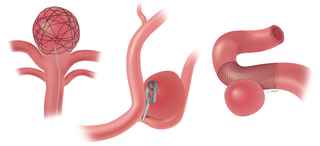Full Spectrum of Brain Aneurysm Care
A brain aneurysm, also called a cerebral aneurysm or intracranial aneurysm, is a weak spot on the wall of a blood vessel in the brain. Blood flowing past the weak spot puts pressure on it and causes it to bulge and swell, creating the aneurysm.
According to the American Stroke Association, some 3 to 5 million people in the U.S. have cerebral aneurysms. Most brain aneurysms don’t rupture or cause symptoms. Unruptured brain aneurysms are often discovered incidentally, during a magnetic resonance imaging (MRI) or computed tomography (CT) scan for an unrelated headache or other condition.
UT Southwestern’s experienced groups of neurosurgeons specialize in evaluating and treating brain aneurysms. Using minimally invasive approaches when appropriate, we perform more pre-emptive surgeries to prevent aneurysm-induced stroke than any medical center in the region, having treated more than 3,000 aneurysms over the past decade.
Our expertise includes a comprehensive range of treatment options for people who have been diagnosed with a brain aneurysm. Physicians work with each patient to determine an appropriate, personalized treatment strategy.
Because of UT Southwestern’s collaborative approach to care – which includes neurosurgeons, neurologists, and neuroradiologists – our team is uniquely equipped to determine if surgery, minimally invasive techniques, or observation will achieve the best outcome.
Symptoms of Brain Aneurysm
A brain aneurysm typically doesn't produce symptoms unless it leaks or ruptures, causing bleeding into the brain. When a leak occurs, the hallmark symptom is a sudden and severe headache – often described as “the worst headache you’ve ever experienced.” Even if a patient has a long history of headaches, this headache will be different. Other symptoms include neck pain and stiffness.
With a ruptured brain aneurysm, patients might also experience stroke symptoms, such as:
- Blurred or double vision
- Confusion
- Drooping eyelid
- Loss of consciousness
- Nausea and vomiting
- Seizure
- Sensitivity to light
- Stiff neck
- Sudden numbness of the face, arm, or leg, especially on one side of the body
A brain aneurysm that has not ruptured but is growing might push against blood vessels or other brain or nerve structures. This pressure can cause symptoms such as:
- Headaches behind the eyes
- Double vision
- New numbness
- Walking difficulties
Ruptured or leaking aneurysms require emergency care. If a person is experiencing any symptoms of a brain aneurysm, call 911 or see a doctor immediately. Early detection of a brain aneurysm provides more options for treatment and better long-term outcomes.
Our Services
For patients who have been diagnosed with an unruptured brain aneurysm, our team of specialists will see them quickly, examining the images a patient already has and, if necessary, performing more diagnostic tests. We aim to complete imaging and consultation in the same day so patients leave with an evaluation of the aneurysm and a discussion of treatment options. Learn more about evaluations for brain aneurysms.
We have every treatment option available for ruptured and unruptured aneurysms, such as:
- Surgical clipping
- Endovascular coiling
- Endovascular flow diversion stents
After treatment, patients recover in our dedicated neurointensive care unit. We also offer neurorehabilitation for those who need physical, occupational, or speech therapy. Learn more about our treatments for brain aneurysms.
We also have expertise in managing conditions that increase the risk of developing brain aneurysms, such as high blood pressure and chronic tobacco use. Learn more about our approach to brain aneurysm risks.









